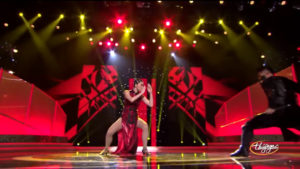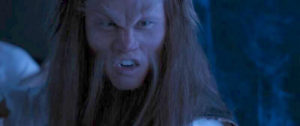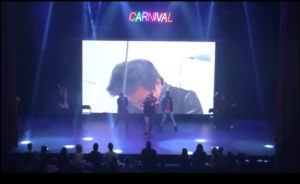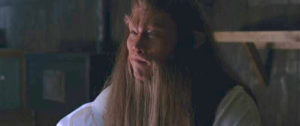By Dr. Craig D. Reid

If you happened to be trying to connect with the dance scene in the early 2010s at the renowned Trocadero Underground near London’s Piccadilly Circus, you might have bumped into the young dance major graduate from Westminster Kingsway, Chris Yong, who at that time would be freelancing and jammin’ using the then popular street performing dance arts of popping, locking, krumping or hip hop. Depending on one’s school of thought, B-boying, which got it’s roots from hip hop and branched out in Brooklyn in the early 1970’s where dancers used early kung fu film moves to wow audiences, if Yong was a teen in the early ’70s, he’d already have those kung fu moves down as his grandmother starting teaching Yong taiji chuan (tai chi) as a wee lad.
With a wee stretch of imagination, something necessary for dance and cinematic martial arts choreography, Yong’s role in the latest adaptation of the 1837 classic story by Hans Christian Anderson, The Little Mermaid, one could say he’s returning to a different circus, something akin to the freak show circus acts created by P. T. Barnum in 1841. Yet in this bleak and dark retelling of Little Mermaid, the ringmaster is much more sinister as Yong’s first major role in film as the freak Ulysses is part of a traveling freak show circus where he’s able to use his knowledge of Hung Gar kung fu (Mandarin Hong Jia Chuen, Hong family style, created by Hong Xi-guan circa 1750 when he combined his tiger claw kung fu with his wife’s white crane skills) to bring a new twist to an old character.
When I spoke with Yong he shared how his two biggest passions in life, dancing and martial arts created a third passion in acting and how becoming a caricature of his character’s namesake, Ulysses (Greek, Odysseus), he’s living his own epic adventure. (Abridged interview with edits.)

Dr. C. Since I’m also from England, I have to ask if you’re football (soccer) fan?
Yong: I was born in Hong Kong, both my parents are Chinese. As a baby I moved to Jakarta, Indonesia then at nine to London. During my school days, I became an Arsenal fan, yet my father and younger brother were Chelsea fans. (London-based teams.)
Dr. C. When did you start martial arts (MA) and why?
YONG: When I was 4 or 5, my grandmother taught me tai chi, I thought it was kung fu. I grew up watching lots Chinese kung fu movies, then after understanding what my grandmother was talking about I learned it was tai chi. Along the way, I began learning Shaolin kung fu, Northern praying mantis, Hung Gar, shotokan (karate), wing chun (Bruce Lee’s foundation…Lee learned Hung Gar before wing chun), jeet kune do (JKD; Lee’s created MA), muay Thai, and [the Japanese arts] ninjutsu, taijutsu and still practicing kenjutsu (Japanese sword).
As a kid learning MA, copying movies, watching Bruce Lee, it was all fun and games. Yet when I got to school in England and was bullied, learning MA was now different. I was an angry kid and MA helped me control my anger and calm my mentality and aggression. When I got out of school and started traveling around the world on my own for work, MA helped by knowing how to survive and assess certain situations. Even growing up in London, I needed to know what is a smart way to avoid a situation or defend myself. I never thought about doing MA in entertainment.

Dr. C. I saw my first kung fu film in 1973, Bruce Lee’s Fists of Fury (1972; aka The Big Boss). After the first two kicks of his first fight, I was inspired to learn what he was doing. Over the years, my Chinese American friends told me that they felt safe in school because of Bruce and the stereotype of Chinese knowing kung fu. They’d share black dudes would say, “Hey, you’re Chinese and know kung fu,” and my friend would say, “That’s right. I’m Chinese.”
YONG: Using the stereotype to their advantage.
Dr. C. There’s an interesting question. Since MA is an important part of Chinese history and culture…is it a stereotype?
YONG: MA is an important part of our history and culture, which actually also helps our upbringing as well and I think it’s something our children need to learn. Apart from knowing how to be self disciplined, have self-respect and respect others, it teaches you how to recognize a situation and how to neutralize it if it’s a threat or how to deescalate a situation.
Dr. C. What was the first martial arts film you saw and how did it impact you?
YONG: Good question. I have a two-part answer. When I was very young and saw this stuff on TV, I loved the flashy moves, Chinese flying movies, fantasy films. I remember seeing Shaolin Kid and Jackie Chan films too. When I became a teenager and looking into different styles, learning several at a time, which I heard from many martial artists that can mess up your core, I wanted to find a style that helped me find my natural self. I looked into jeet kune do, after watching Bruce Lee films. I researched JKD’s philosophy, where everything didn’t have to be so systematic, everyone’s an individual and not every style works for everyone. Then you find a way that suits you as an individual.
With Lee’s movies, I began thinking deeper and the thought behind his thinking. When he made films, he had to sacrifice old habits for the sake of the movie. For example when he has to do high kicks, which he used from tae kwon do (Korean MA), he doesn’t like to do high kicks because in wing chun, he tended to do low kicks.

Dr. C. How did you become interested in dancing?
YONG: At the same time I was learning MA, I learned dancing at six from watching Michael Jackson concerts, shows and music videos, some of which my father brought home on laserdiscs. I’d replay them over and over and copy his dance moves. I was an energetic kid, my mother and father called me a monkey as I’d always climb around.
Dr. C. When did you actually decide to pursue dance as a profession?
YONG: Most parents have high expectations for their kids with education. When I was 16, dancing was my passion so I told my parents I wanted to be professional dancer…an objective they were against. There were lots of arguments back and forth. I had to win them over to prove myself. They supported me a little. So I studied dance at Westminster Kingsway College in London and after two years all my grades came with distinctions. Then over the years as I was also spending time in London and New York City, and understanding that a dance career can be short lived, after much family discussion and knowing I needed to learn another skill, I studied acting at the New York Film Academy.
Then after that, I moved to Los Angeles to experience that industry. Back then, my mind was still dance oriented. I stayed with my cousin and drove to North Hollywood to continued dancing at Debbie Reynolds Dance studio. I remained being a pure dancer.
 Yet one day in 2007, I came across a dojo (MA training school), XMA headquarters, where they did Xtreme Martial Arts. There was a picture out front of actor Mike Chat who used to be a Power Ranger. Being a Power Rangers fan, I was curious as to what he taught. After taking his classes I saw the performance side of MA in entertainment. It was a lot different from what I knew, over exaggerated moves just for performances sake instead of fighting someone for real. (It’s the influence of Beijing Opera combat, which Jackie Chan learned as a kid). It helped me understand how stage combat and stunts worked.
Yet one day in 2007, I came across a dojo (MA training school), XMA headquarters, where they did Xtreme Martial Arts. There was a picture out front of actor Mike Chat who used to be a Power Ranger. Being a Power Rangers fan, I was curious as to what he taught. After taking his classes I saw the performance side of MA in entertainment. It was a lot different from what I knew, over exaggerated moves just for performances sake instead of fighting someone for real. (It’s the influence of Beijing Opera combat, which Jackie Chan learned as a kid). It helped me understand how stage combat and stunts worked.
Though still dancing, I got into an audition that led me into acting where I wanted to play Sub-Zero from Mortal Kombat. I had to use this raspy voice and they wanted me to do a fight scene with Scorpion. Then another pathway opened, a casting call looking for real ninjutsu practitioners. During the audition I was asked about ninjutsu and then they asked strange questions like, “What would you have to do if you wanted to fight a Spartan?” That threw me off and I thought that would never happen. I answered, “If I had shurikens (ninja throwing stars) I’d start throwing them then run away. A Spartan would have advantages on frontal attack due to their armor and huge spear, so I’d try to attack from behind using back stabbing skills.” They called me back and wanted to see how I moved, fight wise and stage combat wise. The coordinator liked how I moved and ended up doing mo-cap (motion capture) work on Activion’s Call of Duty: World at War.

Then I got booked into Deadliest Warrior TV show, the ninja vs. Spartan episode. After that stint they threw me into the Recreation Team, where I wore the whole ninja outfit and worked with all the guys in rehearsals and met more interesting talented stuntmen. It was important to get on set and start building relationships with the coordinators and the team. There’d be times when I wanted to question what they wanted me to do, like cut up a catfish with my fingers. A stunt coordinator could tell I was new to this and was kind enough to whisper in my ear just to keep quiet, work it, then move on.
Dr. C. You’re the first actor I’ve met in America who is a solid professional dancer and martial artist plus the first actor I could ever have asked this question. When it comes to dance choreography and fight choreography, what are their differences, especially since when you do stage it’s totally different from film and TV?
YONG: I would thank dance first off, fortunately for help putting me through memory exercises for doing the dance choreography, training and rhythm, which was a big plus if you have to learn long choreography routines for a fight. The difference is when you are on film you can make a mistake and re-shoot it, plus a fight can be split into segments. Though sometimes you can also learn the dance choreography in segments, they’d sometimes make us you do the whole choreographed dance and then do it again. The big difference with live stage is you have to keep the show going. [If you make a mistake] you can’t stop, you are in the moment, you keep going as the music plays.
With fighting, the choreography rhythm is different. Every action is a reaction. If someone throws a punch you have to react to the punch, you can’t anticipate it. If it’s late, you react to it then, and that breaks the rhythm. You have to work with the partner and that’s all about trust in your partner and the team member you’re fighting with.

On live stage dancing, everyone knows the choreography and their placement and what their objectives are. In fights, you must know your spacing, be aware, make adjustments for safety reasons and take others into consideration because they don’t want to be hurt, and you don’t want to be hurt, everyone wants to be safe to be able to work another day.
Dr. C. For your latest film The Little Mermaid, I read that casting started via Facebook where the filmmaker was looking for someone with martial art expertise. This is new to me, could you explain how that worked and how you landed the role of Ulysses please?
YONG: When I saw the casting notice it was first on a small Facebook group for Asian American actors and at the post read, “Looking for well built Asian man, 20-30s, who can be portrayed as a beast man and must have a body like Bolo Yeung.”
Note: Real name is Yang Zi. He was a 10-time Mr. Hong Kong bodybuilder champion who was cast as the villain character Bolo in Bruce Lee’s Enter the Dragon (1973).
Shortly after responding to the casting call, the casting director asked me to attend casting in person in Miami, Florida. I was in LA. The casting director said to send a tape of me portraying the character using his dialogue. Because I was training at the gym Joining all Movement (JAM), I borrowed one of their dance studios and had two friends help me. When I read the sides (lines) I needed to remove my shirt to show my physique then throw in my own flavor. My friend filmed me running like a beast man on all fours, jumping over a block, doing flips and other character movements.

First thing I thought of was Beast from X-Men. Couple weeks later I was performing a Chinese Lion Dance and during a break got a call that the director wanted to see me. I was very excited. When they asked could I come to Georgia, I replied, “When do you need me?” Next week. I was ready to drop everything to go to Savannah, Georgia.
Dr. C. Who is Ulysses and how did you prepare for the character?
YONG: They gave me freedom to create the character, to come up with my background, the reason why he was in America with this circus troupe. So Ulysses was born in China, where parents abandon many kids, a lot of these children have abnormalities. It was cruel society back then if you had a deformed child, they’d abandon them. I’ve seen a lot of these children first hand during my trips. I saw that Ulysses was dropped off in front of a temple where he was taken care off by a monk and was being picked on by local kids,
A Warlock during his times of travel came across Ulysses and offers me salvation, saying if I follow him he can perform magic on my abnormality and fix me. Ulysses is a young child and agrees. The Warlock recognizes that he has a vast amount of strength, and I’m very strong willed so he brings Ulysses to America as a child to be raised in America. But I eventually realize the Warlock is tricking me, he couldn’t make me more human, instead he treated me like a Chinese [Foo] dog. Yet he had no power to confront the Warlock as a wall of magic is restraining him. The Mermaid was also tricked. Hence we’re traveling circus of oddities, freaks under one tent, his front being that we’re magical creatures. Yet we really are all magical creatures.

Dr. C. What sort of martial arts did they have you do?
YONG: They left that to me. I was born in the Year of the Tiger, as was my father and grandfather. I learned a tiger form from Hung Gar. I had to wear prosthetics on my face for long hours. (Like his dance hero Michael Jackson did on Thriller as the werewolf.) For the Beastman my natural instinct was to think what the character’s mindset would be. Ulysses has claws and roars like a lion, so I used tiger claw…a catlike Foo dog. I could use the tiger’s cat stances. When it came to fighting I swung my arms to scratch with my fingers like in the tiger claw form. The fights for Ulysses were grounded, nothing flashy, down to earth. I tried to keep the Hung Gar moves simple so the director could understand what my character’s train of thought was.
Dr. C. I really appreciate your time Chris, so just a few final questions please.
YONG: No problem, I’m enjoying speaking with you.
Dr. C. You’ve practiced many MA. Which ones particularly resonate with you?
YONG: Two-part answer…intention of film and the intention of reality. JKD helped me to find my own naturalism. JKD, kung fu and ninjutsu was for reality-based aspects of MA. As for the fighting style in Hollywood, it was about making things flashy. I’m proficient in Chinese swords and using the Japanese katana, and can add to that flash with wushu and I’m trying to develop tae kwon do kicks, which right now the kicks are out of my element. When it comes to fists, boxing.
 Dr. C. What has martial arts taught you and what is your life’s philosophy?
Dr. C. What has martial arts taught you and what is your life’s philosophy?
YONG: Martial arts has been a big part of my life. And when it comes to that philosophy, we all understand what Bruce Lee means when he says be like water, be still yet ever flowing. I really follow this and I use it when I do physical training as well as using no limitation as limitation. It’s a good mentality to have because if you have limitation then you get stuck there, you can’t progress. When you can pass your limit then you can achieve more, and get more from your self-motivation, not only in training, but also in what you do in life, whether it’s work, creativity or your relationships with people. Lot of morals in MA help me understand the morals of self-respect and respect for others too. As mentioned before when I was an angry kid with a bad temper, MA helped me calm my temper and aggression, made me clearer and helped me develop a calmer mind.
As a philosophy of life? (thoughtful pause) I know I want to question myself a lot of times. Everyone has a different perspective on life, to me, as long as you understand that in life there is a balance, there’s always good and also evil. I also believe in karma as long as you always treat others well with respect, nice and kindness. With an act of kindness, you’ll be rewarded back with more kindness.